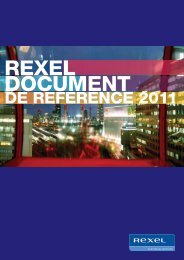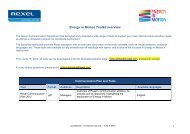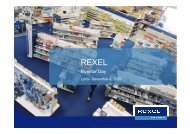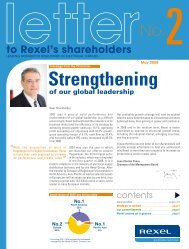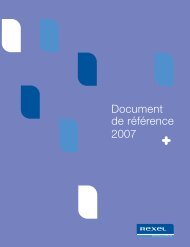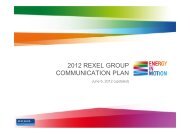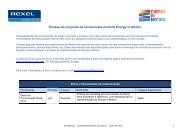2008 Registration Document - Rexel
2008 Registration Document - Rexel
2008 Registration Document - Rexel
Create successful ePaper yourself
Turn your PDF publications into a flip-book with our unique Google optimized e-Paper software.
14. Financial information concerning the assets andliabilities, financial position and profits and lossesof <strong>Rexel</strong>still expected to occur, the cumulative gain or loss at thatpoint is retained in equity and is recognized in accordancewith the above policy when the transaction occurs. If thehedged transaction is no longer expected to take place,then the cumulative unrealized gain or loss recognized inequity is recognized immediately in profit or loss.Fair value hedgesFair value hedge accounting is used when a derivativefinancial instrument is designated as a hedge of thevariability of the fair value of a recognized asset or liability (orfirm commitment), including fixed rate indebtedness suchas indexed bonds and other fixed rate borrowings.The hedging instrument is measured at fair value withchanges in fair value recognized in the income statement.The hedged item is remeasured to fair value in respect ofthe hedged risk. Any resulting adjustment to the carryingamount of the hedged item related to the hedged risk isrecognized in the income statement.Hedge of monetary assets and liabilities denominated inforeign currencyWhen a derivative financial instrument is used as aneconomic hedge of the foreign exchange exposure of arecognized monetary asset or liability, hedge accounting isnot applied and any gain or loss on the hedging instrumentis recognized in profit or loss (“natural hedge”).2.9.6 Cash and cash equivalentsCash and cash equivalents comprise cash balances anddemand deposits with banks and other short-term highlyliquid investments subject to an insignificant risk of changesin value.2.10 Non-current assets held for sale anddiscontinued operationsNon current assets and disposal groups are classifiedas held for sale if their carrying amount will be recoveredthrough a sale transaction rather than through continuinguse. This condition is regarded as met only when the saleis highly probable and the asset (or disposal group) isavailable for immediate sale in its present condition. TheGroup must be committed to the sale which should beexpected to qualify for recognition as a completed salewithin one year from the date of classification. Immediatelybefore classification as held for sale, the measurement ofthe assets (and all assets and liabilities in a disposal group)is brought up to date in accordance with applicable IFRS.Then, on initial classification as held for sale, non-currentassets and disposal groups are recognized at the lower oftheir carrying amount and fair value less costs to sell.2.11 Share capitalRepurchase of equity instrumentsWhen an equity instrument is repurchased by the entity,the amount of the consideration paid, including directlyattributable costs, is recognized as a change in equity.Repurchased shares that are not subsequently cancelledare classified as treasury shares and presented as adeduction from total equity.DividendsDividends are recognized as a liability in the period in whichthe distribution has been approved by the shareholders.2.12 Financial liabilitiesInterest-bearing borrowingsInterest-bearing borrowings are recognized initially at fairvalue less attributable transaction costs. Subsequent toinitial recognition, interest-bearing borrowings are stated atamortized cost with any difference between the proceeds(net of the transaction costs) and redemption value beingrecognized in the income statement over the period of theborrowings on an effective interest rate basis.Effective interest rateThe effective interest rate is the rate that exactly discountsthe expected stream of future cash flows through to maturityto the current net carrying amount of the liability on initialrecognition. When calculating the effective interest rate ofa financial liability, future cash flows are determined on thebasis of contractual commitments.Transaction costsTransaction costs are incremental costs that are directlyattributable to the issue of the financial liability. Transactioncosts include fees and commissions paid to agents andadvisers, levies by regulatory agencies and securitiesexchanges, and transfer taxes and duties. Transactioncosts do not include debt premiums, or allocations ofinternal administrative or overhead expenses.For financial liabilities that are carried at amortized cost,transaction costs are included in the calculation of amortizedcost using the effective interest rate method and, in effect,amortized through the income statement over the life of theinstrument.Net financial debtNet financial debt includes interest-bearing borrowings andaccrued interest less cash and cash equivalents.2.13 Employee benefitsGroup companies operate various pension schemes. Someof these schemes are funded by insurance companiesor trustee-administered funds in accordance with localregulation.Pension and other long-term benefits include two categoriesof benefit:− post-employment benefits including pensions, medicalbenefits after retirement and severance payments,− other long-term benefits (during employment) mainlyincluding jubilees and long service leaves.These benefits are classified as either:− defined contribution plans when the employer paysfixed contributions into a separate entity recognized asPAGE 166 | REXEL <strong>2008</strong>





